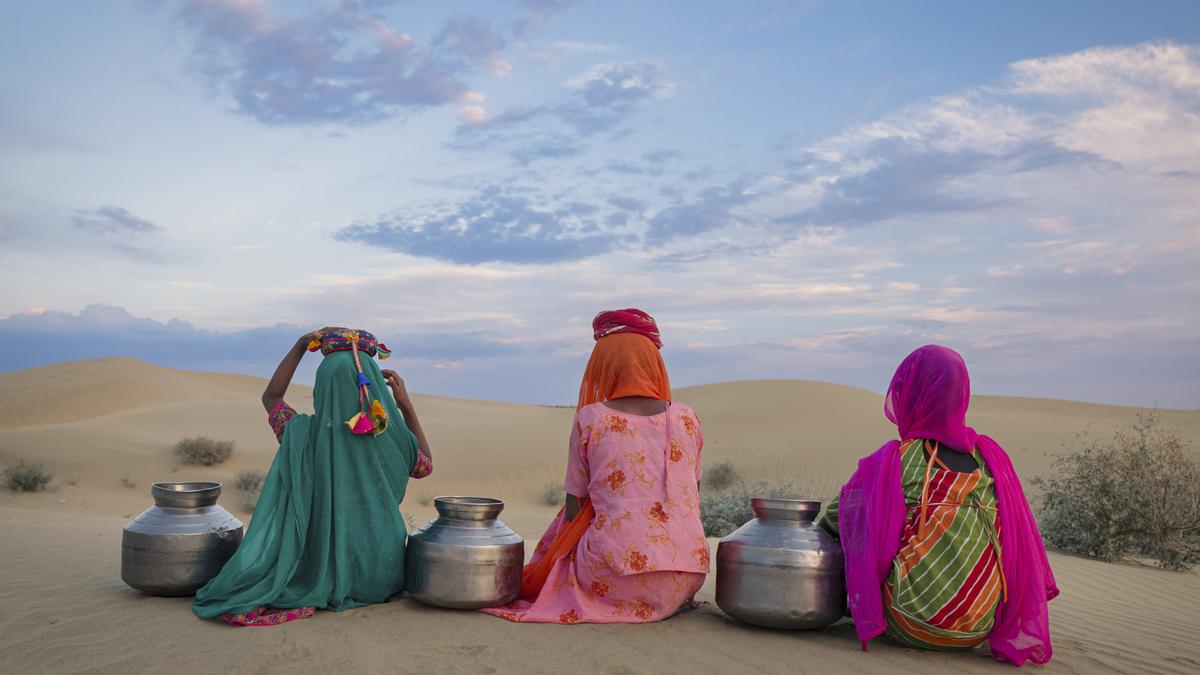Source: TH
Table of Contents
ToggleRelevance: GS 2 & GS 3: Social Justice, Environment
Mains: ‘Climate Change’ is a global problem. How will India be affected by climate change? How Himalayan and coastal states of India be affected by climate change? (2017)

Impact of Climate Change on Women:
- Food Insecurity Amplified: Climate-induced reductions in crop yields exacerbate food insecurity, particularly affecting impoverished households already grappling with higher levels of malnutrition.
- Gendered Economic Struggles: Among small and marginal landholding families, men encounter social stigma stemming from unpaid loans, prompting migration, emotional distress, and, tragically, suicides.
- Disproportionate Burden on Women: Women bear a heavier load of domestic responsibilities, leading to deteriorating health and increased vulnerability to intimate partner violence.
- Drought-Prone Districts: National Family Health Survey (NFHS) 4 and 5 findings reveal that women residing in districts prone to drought exhibit:
- Higher rates of underweight conditions.
- Increased incidence of intimate partner violence.
- Elevated prevalence of underage marriages for girls.
Health Implications:
- Heightened food and nutritional insecurity, coupled with uncertain incomes and heightened workloads, contribute to poor physical health among women.
Mental and Emotional Toll:
- Climate change-induced stressors negatively impact women’s mental health and emotional well-being.
Gender-Based Violence and Climate Change:
Vulnerability to Hydromet Disasters:
- A 2021 report by the Council on Energy, Environment and Water (CEEW) revealed that 75% of Indian districts are susceptible to hydromet disasters like floods, droughts, and cyclones.
- NFHS 5 data indicates that more than half of women and children residing in these districts face heightened risks.
Correlation with Natural Disasters:
- Increasingly, studies are demonstrating a direct link between these natural calamities and gender-based violence against women.
Impact on Access to Safe Drinking Water:
- Extreme weather events and alterations in water cycle patterns significantly impede access to safe drinking water, intensifying women’s workload and reducing time available for productive work and healthcare.
Health Risks for Vulnerable Groups:
- Prolonged heat poses grave threats, especially to pregnant women, increasing the likelihood of preterm birth and eclampsia, as well as posing risks to young children and the elderly.
Health Impacts of Air Pollution:
- Exposure to indoor and outdoor pollutants detrimentally affects women’s health, leading to respiratory and cardiovascular diseases, and impairs the physical and cognitive growth of unborn children.
Cohort studies from India reveal alarming statistics:
Every 10 micrograms per cubic meter increase in PM2.5 heightens the risk of:
- Lung cancer by 9%.
- Cardiovascular deaths on the same day by 3%.
- Stroke by 8%.
- Dementia by 4% for every 2 micrograms increase in annual PM2.5.
The Importance of Women in Climate Action:
- Achieving Climate Goals: Climate action necessitates the participation of all individuals to meet the Paris Agreement target of limiting global temperature rise to 1.5°C.
- Enhancing Agricultural Productivity: Empowering women with equal access to resources can significantly boost agricultural yields, with studies showing an increase of 20% to 30% when women are provided with the same resources as men.
- Leadership in Environmental Conservation: Women, particularly tribal and rural women, have often been pioneers in environmental conservation efforts, showcasing their leadership and commitment to sustainability.
- Local Solutions through Empowerment: Providing women and women collectives, such as Self-help Groups and Farmer Producer Organisations, with knowledge, tools, and access to resources can foster the emergence of localized solutions to environmental challenges.
- Tailored Adaptation Measures: Recognizing the diverse contexts of rural and urban areas, adaptation strategies need to account for variations in exposure to heat, air pollution, and access to water and food. Empowering women in both settings ensures that adaptation measures are inclusive and effective.
Effective Involvement of Women in Climate Change Plans: Best Practices
- Transition to Clean Energy: Initiatives like Charlot Magayi’s project in Kenya facilitate the transition from traditional, polluting cook burners to cleaner alternatives, improving community health while reducing greenhouse gas emissions.
- Empowerment through Renewable Energy: Programs such as Solar Sister, led by African women, empower communities to adopt small-scale solar systems, fostering energy independence and simultaneously reducing greenhouse gas emissions and air pollution.
- Integration of Female Expertise: Female scientists across Africa contribute invaluable insights from their firsthand knowledge of local conditions and agriculture, bridging gender gaps in research and development efforts.
- Enhancing Women’s Influence in Policy: The Gender and Climate Change Development Programme in South Asia aims to amplify women’s voices in policy-making processes, empowering them to contribute meaningfully to climate change mitigation and adaptation strategies.
- Capacity Building for Climate Resilience: Initiatives like the Self-Employed Women’s Association (SEWA) in India provide training to women farmers on responding to shifting climate patterns, equipping them with the skills and knowledge needed to enhance their financial resilience amidst environmental challenges.
Way Forward
Mitigating Heat Impacts on Vulnerable Groups:
- Prioritize the protection of outdoor workers, pregnant women, infants, young children, and the elderly from prolonged heat exposure through targeted interventions.
Empowering Local Authorities:
- Equip urban local bodies, municipal corporations, and district authorities in vulnerable districts with comprehensive plans, training, and resources to effectively implement heat wave response strategies.
Early Warning Systems and Response Measures:
- Implement heat wave warnings based on local temperature and humidity, adjust outdoor work and school schedules, establish cooling rooms in health facilities, provide public drinking water facilities, and ensure immediate treatment for heat stroke cases to minimize fatalities.
Long-Term Urban Planning:
- Enhance urban planning efforts by increasing tree cover, reducing concrete surfaces, creating green-blue spaces, and designing heat-resilient housing to mitigate the impact of rising temperatures.
Innovative Solutions for Heat Reduction:
- Explore innovative approaches like roof painting with reflective white paint, as demonstrated by the Mahila Housing Trust in Udaipur, to reduce indoor temperatures and improve quality of life in low-income households.
Revitalizing Traditional Water Management:
- Revive traditional rainwater harvesting and storage systems, leveraging geographic information systems to map water sources, identify vulnerabilities, and develop localized water access improvement plans, as exemplified by the work of the M.S. Swaminathan Research Foundation in Tamil Nadu.
Community-Led Resilience Building:
- Foster convergence of sectors and services at the village or panchayat levels, empowering local communities through devolution of powers and finances, and capacity building of panchayat and Self-Help Group (SHG) members to lead resilience-building efforts.
Gender-Inclusive Climate Action:
- Apply a gender lens to all State-action plans on climate change, ensuring the National Action Plan on Climate Change (NAPCC) and State Action Plans on Climate Change (SAPCC) recognize and address the specific impacts on women. Emphasize transformative approaches and gender-responsive strategies to promote comprehensive and equitable climate adaptation.






